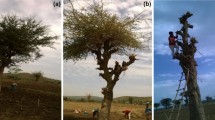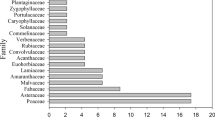Abstract
Field trials were carried out on an Oxic Paleustalf in the humid zone of southwestern Nigeria withLeucaena leucocephala (Lam.) de Wit,Gliricidia sepium (Jacq.) Steud. andSesbania grandiflora (L.) Pers. alley cropped with maize and cowpea. The three leguminous woody species were grown in hedgerows spaced at 2 m. Trials were carried out one year after establishment of the hedgerows using a split-plot design with four replications. TheLeucaena trial had twenty pruning combinations consisting of five pruning heights (25, 50, 75, 100 and 150 cm) and four pruning frequencies (monthly, bi-, tri- and six-monthly). TheGliricidia andSesbania hedgerows were subjected to nine pruning intensities consisting of three pruning heights (25, 50 and 100 cm) and three pruning intensities (monthly, tri- and six-monthly).
For the three woody species, biomass, dry wood and nitrogen yield from the hedgerow prunings increased with decreasing pruning frequency and increasing pruning height. Biomass, dry wood and nitrogen yields were in the following orderLeucaena >Gliricidia >Sesbania.
The various pruning intensities had no effect on survival ofLeucaena plants. Pruning frequency had a larger effect than pruning height on survival ofGliricidia andSesbania plants. With monthly pruning, about 25 percent of theGliricidia and all of theSesbania plants died within six months of repeated pruning. Even with lower pruning frequencySesbania plants showed lower survival rates thanGliricidia orLeucaena.
The various pruning intensities of all the hedgerow species had more pronounced effects on the grain yield of the alley cropped cowpea than on maize grain yield. Higher maize and cowpea yields were obtained with increasing pruning frequency and decreasing pruning height.
Similar content being viewed by others
References
Brewbaker JR van den Beldt and K MacDicken (1982) Nitrogen-fixing tree resources, potentials and limitations. In Graham PH and SC Harris (eds). Biological nitrogen fixation technology for tropical agriculture, CIAT, Cali, Columbia: 413–425
Burbridge MT (1965) The Australian species ofSesbania scopoli (Leguminose). Australian Journal of Botany 13: 103–141
Chadhokar PA (1982) Gliricidia maculata a promising legume fodder plant. World Anim Rev 44: 36–43
Das RB and GS Dalvi (1981) Effect of interval and intensity of cutting of Leucaena leucocephala. Leucaena Research Report 2: 21–22
Dijkman MJ (1950) Leucaena — A promising soil-erosion control plant. Econ Bot 4: 337–349
Guevarra AB, AS Whitney and AR Thompson (1978) Influence of intrarow spacing and cutting regimes on growth and yield of Leucaena. Agron J 70: 1033–1037
Kang BT and B Duguma (1985) Nitrogen management in alley-cropping systems. In: Kang BT and J van der Heide (eds) Nitrogen management in farming systems in humid and subhumid tropics. Inst for Soil Fertility (IB) Haren, Netherlands: 269–284
Kang BT, H Grimme and TL Lawson (1985) Alley cropping a sequentially cropped maize and cowpea withLeucaena on sandy soil in southern Nigeria. Plant and Soil 85: 267–277
Kang BT, GF Wilson and TL Lawson (1984) Alley cropping — a stable alternative to shifting cultivation. Int Inst Trop Agric Ibadan, Nigeria, 23 pp
Kang BT and ASR Juo (1983) Management of low activity clay soils in tropical Africa. In Beinroth FH, H Neel and H Nswaran (eds) Proc fourth Int Soil Classification Workshop Rwanda 1981, ABOS-AGCD Brussels: 450–470
Kang BT, GF Wilson and L Sipkens (1981) Alley cropping maize (Zea mays L.) andLeucaena (Leucaena leucocephala Lam.) in southern Nigeria. Plant and Soil 63: 165–179
Krishna Murthy K and MK Mune Gowda (1982) Effect of cutting and frequency regimes on the herbage yield of Leucaena. Leucaena Research Report 3: 31–32
Moormann FR, R Lal and ASR Juo (1975) The soils of IITA. Technical Bulletin 3, IITA, Ibadan, Nigeria, 48 pp
National Academy of Sciences (1980) Firewood crops. NAS, Washington D.C. 236 pp
Osman AM (1981) Effects of cutting intervals on relative dry matter production of four cultivars of leucaena. Leucaena Research Report 2: 33–35
Pathak PS and BD Patel (1982) Leucaena research at the Indian Grassland Fodder Research Institute. In: Leucaena Research in the Asian-Pacific region. IDRC, Ottawa, Canada: 83–88
Rachie KD (1983) Intercropping tree legumes with annual crops. In: Huxley PA (ed) Plant Research and Agroforestry. ICRAF, Nairobi, Kenya. 103–116
Schweitzer J (1939) Over de functie van het blad bij het cultuurgewas gedurende een vegetatie-periode. De Bergcultures 13: 1628–1639
Takashi M and JC Ripperton (1949) Koa Haole, Hawaii Agr Expt Sta Rpt 1943-1944: 46–48
Author information
Authors and Affiliations
Additional information
IITA Journal paper number 335
Rights and permissions
About this article
Cite this article
Duguma, B., Kang, B.T. & Okali, D.U.U. Effect of pruning intensities of three woody leguminous species grown in alley cropping with maize and cowpea on an alfisol. Agroforest Syst 6, 19–35 (1988). https://doi.org/10.1007/BF02344743
Issue Date:
DOI: https://doi.org/10.1007/BF02344743




